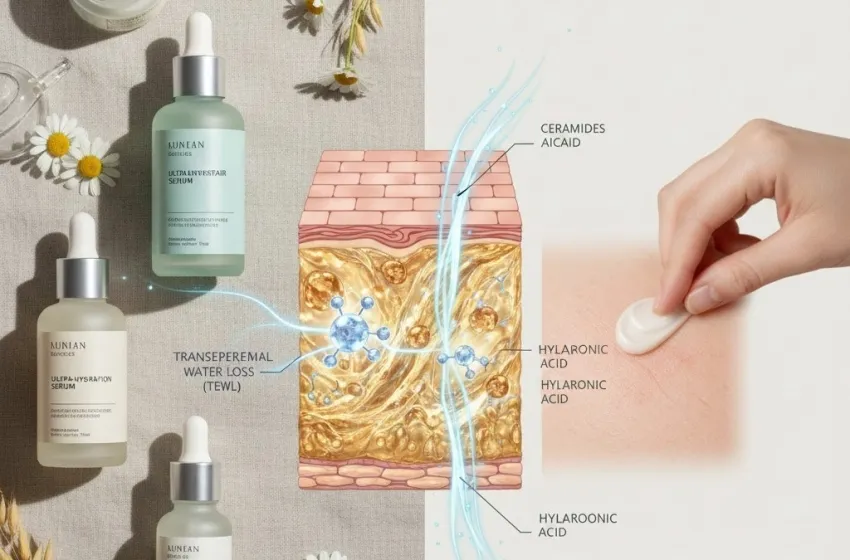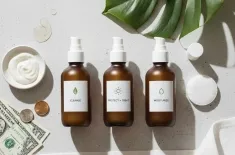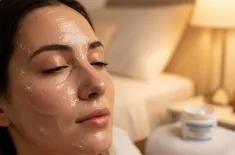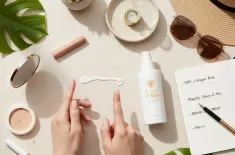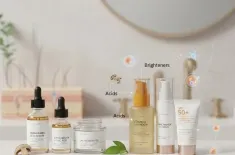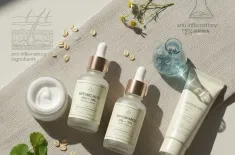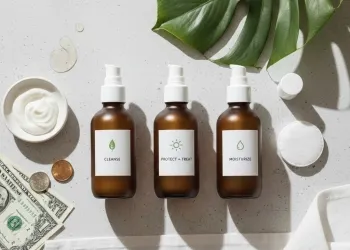Learn the science behind barrier repair, how over-exfoliation causes a damaged skin barrier, and a product guide focusing on ceramides
The beauty industry is currently witnessing a significant shift, moving away from aggressive, multi-step routines toward a focus on fundamental skin health. At the heart of this evolution is the Rise of Barrier Repair Skincare. This movement champions the idea that a strong, healthy skin barrier is the foundation of a radiant complexion, and it has prompted a surge in products specifically formulated to mend, protect, and soothe compromised skin.
Understanding the Skin Barrier
To appreciate the importance of barrier repair, one must first understand the structure and function of the skin barrier, often described as the "brick and mortar" of the outermost layer of your skin, the stratum corneum.
The Brick and Mortar Model
The "bricks" are the flattened skin cells (corneocytes), and the "mortar" is the lipid replenishment matrix composed primarily of ceramides, cholesterol, and fatty acids. This meticulously organized structure serves two critical purposes:
- Defense: It acts as a shield, protecting the body from external threats like bacteria, pollution, irritants, and allergens.
- Hydration Regulation: It prevents excessive water loss from the skin's surface, a process known scientifically as transepidermal water loss (TEWL).
When the barrier is intact, skin feels smooth, plump, and resilient. However, when the "mortar" is depleted or damaged skin barrier, the skin's ability to hold onto water is severely compromised, leading to a host of issues.
The Science Behind a Compromised Skin Barrier
A compromised or damaged skin barrier is the root cause of countless skin complaints, from chronic dryness to heightened sensitivity. The disruption is often a result of modern skincare habits and environmental stressors.
Chemical and Physical Stressors
The most common culprit in barrier breakdown is over-exfoliation. Driven by the desire for instant gratification, many people use harsh chemical exfoliants (AHAs, BHAs) or physical scrubs too frequently or in too high a concentration. This strips away the natural lipid matrix faster than the skin can repair it, creating micro-fissures in the barrier.
Similarly, using harsh, alkaline cleansers (like traditional bar soaps) or high-pH toners can disrupt the skin's slightly acidic natural mantle (the acid mantle, with an optimal $\text{pH}$ of approximately $5.5$), leading to irritation and increased susceptibility to damage.
Clinical Manifestations of Damage
When the barrier is weakened, the skin becomes permeable, leading to a cascade of negative effects:
- Increased TEWL: The primary sign of a damaged skin barrier is a drastic increase in transepidermal water loss (TEWL). As water evaporates easily through the compromised surface, the skin becomes dry, flaky, and tight.
- Inflammation: Foreign substances (irritants, pollutants) can penetrate deeper into the skin, triggering the immune system and causing chronic inflammation, characterized by redness, stinging, and itching. Conditions like eczema, rosacea, and dermatitis are often directly linked to a genetically or chronically damaged barrier.
- Dehydration and Sensitization: Even oily skin types can experience dehydration due to high TEWL, and become sensitized, reacting to products that were previously tolerated.
The chemical structure of a healthy lipid matrix features an optimal ratio of ceramides, cholesterol, and free fatty acids. When this ratio is unbalanced, the barrier’s integrity fails, making topical lipid replenishment essential for recovery.
Core Ingredients for Barrier Repair: The Power Trio
The barrier repair trend is powered by science-backed ingredients proven to mimic and restore the skin’s natural composition. The focus is on rebuilding the "mortar" and flooding the skin with humectants to reverse the effects of transepidermal water loss (TEWL).
Ceramides: The Barrier Architect
Ceramides are the undisputed cornerstone of barrier repair. These are waxy lipid molecules ($\text{N}$-acyl-sphingosines) found in high concentrations within the cell membranes in the stratum corneum. They comprise up to $50\%$ of the lipid matrix and are essential for maintaining cohesion and preventing water loss.
- Function: They literally hold the skin cells together, forming a waterproof, protective layer.
- Product Guide Focus: Look for formulas containing "Ceramide NP," "Ceramide AP," or "Ceramide EOP," often in conjunction with cholesterol and fatty acids to ensure complete lipid replenishment. The goal is to provide the exact components the damaged skin barrier is missing.
Hyaluronic Acid: The Hydration Magnet
While not a lipid, hyaluronic acid is a crucial supporting player. It is a powerful humectant—a substance that attracts and holds water—with the remarkable capacity to bind over $1,000$ times its weight in water.
- Function: It acts like a sponge, drawing moisture into the top layer of the skin, which is essential to counteract the dehydration caused by high TEWL. It plumps the skin and improves elasticity, creating a hydrated environment crucial for barrier repair to occur.
- Product Guide Focus: Often listed as Sodium Hyaluronate (its salt form), it provides immediate hydration and comfort, soothing the irritation associated with dry, compromised skin.
Occlusives and Emollients (Lipid Replenishment)
Ingredients like Shea Butter, Squalane, Petrolatum, and Dimethicone fall into the categories of emollients (softening and smoothing) and occlusives (physically blocking water loss).
- Function: They reinforce the protective layer, minimizing transepidermal water loss (TEWL) until the skin can produce enough of its own lipids. They are integral to providing comprehensive lipid replenishment.
Product Guide: Repairing and Soothing with Ceramide-Rich Formulas
The most effective way to address a damaged skin barrier is through a simplified routine focusing entirely on gentle cleansing, targeted repair, and protection.
| Routine Step | Product Type Focus | Key Ingredients | Why it Works |
|---|---|---|---|
| Cleanse | Low-pH, Non-foaming Milk/Gel Cleanser | Glycerin, Colloidal Oatmeal, Panthenol | Cleans without stripping the acid mantle or essential lipids, preventing further irritation. |
| Repair & Soothe | Ceramide-Rich Serum or Balm | Ceramides (NP, AP), Cholesterol, Fatty Acids | Directly replenishes the lost "mortar" for targeted lipid replenishment, sealing the barrier. |
| Hydrate | Essence or Serum with HA | Hyaluronic Acid, Glycerin, Niacinamide | Floods the skin with moisture to reverse dehydration caused by TEWL and calms inflammation. |
| Protect | Emollient/Occlusive Moisturizer | Petrolatum, Squalane, Shea Butter, Dimethicone | Provides an immediate, temporary seal against further water loss and environmental stress. |
| Daytime Must | Mineral Sunscreen (SPF 30 ) | Zinc Oxide, Titanium Dioxide | Essential for preventing UV-induced inflammation and further barrier damage. |
The Shift to a Simplified Routine
The rise of barrier repair skincare is intrinsically linked to the adoption of a simplified routine, often dubbed "Skinimalism."
The Anti-Inflammatory Approach
Many consumers are now recognizing that layering multiple active ingredients (Vitamin C, Retinol, multiple acids) can lead to chronic low-level irritation that prevents barrier healing. A simplified routine deliberately strips back the number of products and ingredients, reducing the chemical load on the skin.
- Focus on Tolerance: Instead of aiming for aggressive cell turnover, the focus shifts to skin tolerance, comfort, and long-term resilience.
- Resting the Barrier: When the barrier is acutely damaged skin barrier, the only actives permitted are soothing, healing ingredients like Centella Asiatica (Cica), Allantoin, and Panthenol, along with the core ceramides and hyaluronic acid. This gives the skin's natural repair mechanisms the best chance to recover.
In conclusion, the Rise of Barrier Repair Skincare is not a fleeting trend but a fundamental recalibration of skincare philosophy. It teaches that healthy skin is synonymous with a robust barrier. By prioritizing lipid replenishment with ingredients like ceramides and combating moisture loss with hyaluronic acid to address transepidermal water loss (TEWL), consumers are moving away from the cycle of over-exfoliation and irritation toward a foundation of lasting skin health, encapsulated by a simplified routine built on scientific efficacy.
